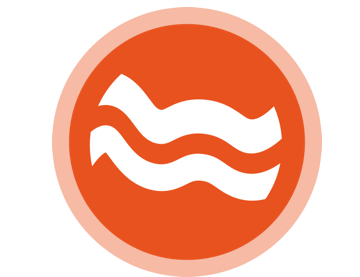There are four key components of an AGP:
- Median
- 25th–75th Percentile
- 5th–95th Percentile
- Target Glucose Range
Each of these elements tells a clear story about your patients’ glucose control and variability over a selected time period.
Each of these elements tells a clear story about your patients’ glucose control and variability over a selected time period.
The ‘average’ (middle) point of all glucose levels that shows ‘what usually happens’ during a day.2 Look at whether it is in the target glucose range and how much it swings up and down throughout the day.
This band indicates where glucose levels are ‘half the time’. Look at width of the band throughout the day. The wider this band is, the more variable the glucose levels are day-to-day.2
This band indicates more ‘occasional’ high or low glucose levels. Look at areas where the band is widest, this indicates more day-to-day variation at these times.2
This is the corridor where glucose levels should be as much as possible. According to international consensus, the target glucose range is usually 3.9 mmol/L–10 mmol/L for adults with type 1 and type 2 diabetes who are not pregnant, not older, or at risk.1

LibreView is a secure, cloud-based diabetes management system. It provides both healthcare professionals and patients with access to a consistent set of clear, intuitive reports that make it easier and faster to discover patterns and trends.
With the AGP report on LibreView you can:
Read real-life case studies from local health authorities who have successfully initiated access to glucose-sensing technology.
References & Disclaimers
Images are for illustrative purposes only. Not real patient, data, or healthcare professional.
1. Wright, E. J Fam Pract (2015).
2. Gibb, F. W., Jennings, P., Leelarathna, L., & Wilmot, E. et al. AGP in Daily Clinical Practice: A guide for use with the Freestyle Libre Flash Glucose Monitoring System. British Journal of Diabetes. Retrieved June 30, 2022, from https://doi.org/10.15277/bjd.2020.240
3. Battelino T, Danne T, Bergenstal RM, et al. Clinical targets for continuous glucose monitoring data interpretation: recommendations from the international consensus on time in range. Diabetes Care. (2019);42(8):1593-1603.
₼ The LibreView website is only compatible with certain operating systems and browsers. Please check www.LibreView.com for additional information.
ADC-57902 v4.0
The "Yes" link below will take you to a website other than Abbott Laboratories. Links to other websites are not under the control of Abbott Laboratories, and Abbott Laboratories is not responsible for the content of such websites or any link contained in such websites. Abbott Laboratories is providing these links to you only as a convenience, and the inclusion of any link does not imply endorsement by Abbott Laboratories of the site.
Do you want to leave this page?
If you're a healthcare professional located in a different country, please select your country's website from the list of our global sites or contact your local Abbott representative for correct information about the products available in your country.
If you're not a healthcare profressional, click here to go to the FreeStyle Libre consumer website for the UK.